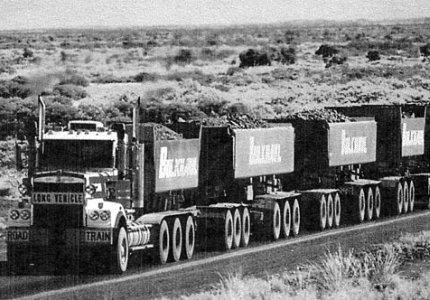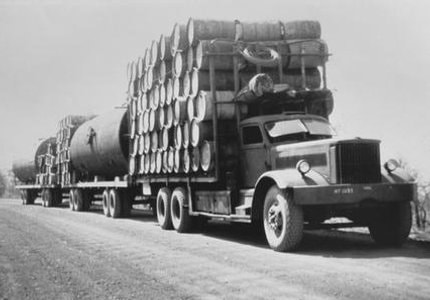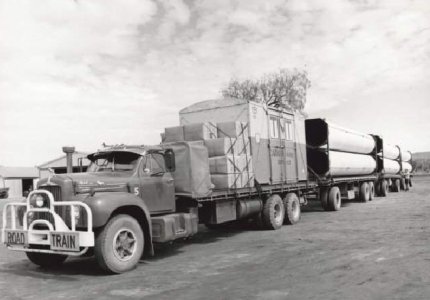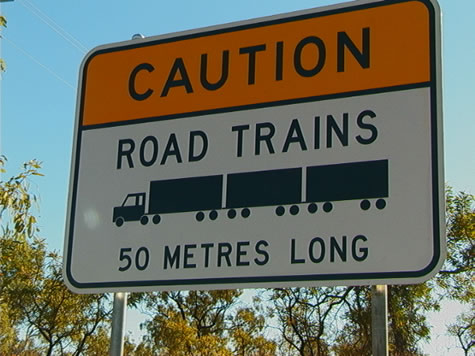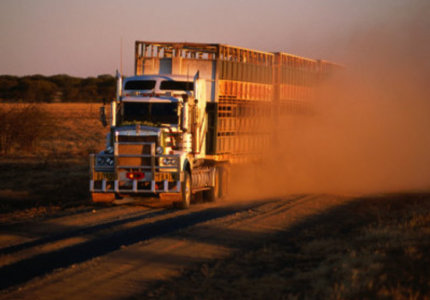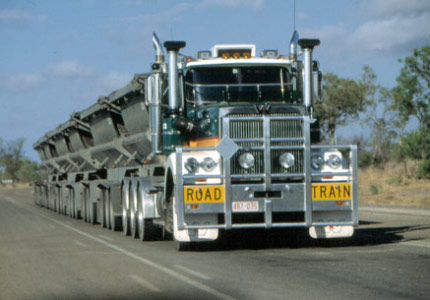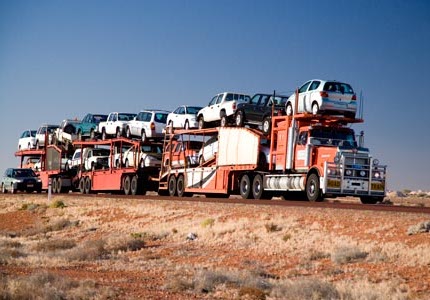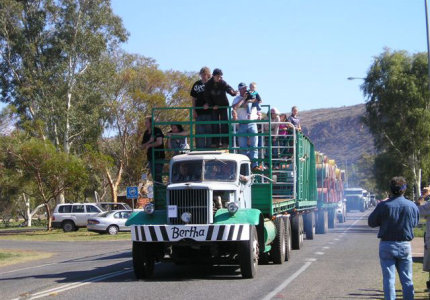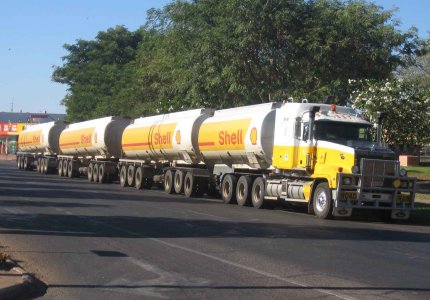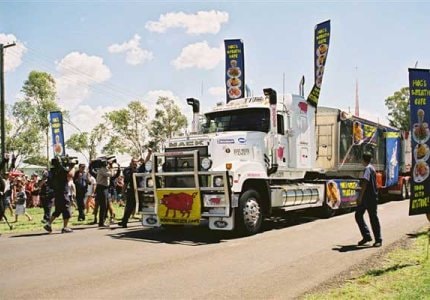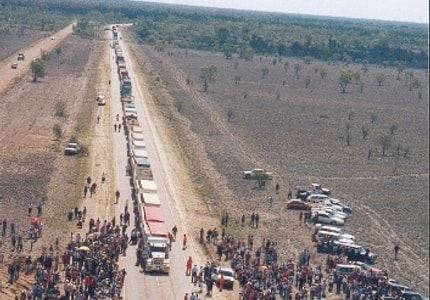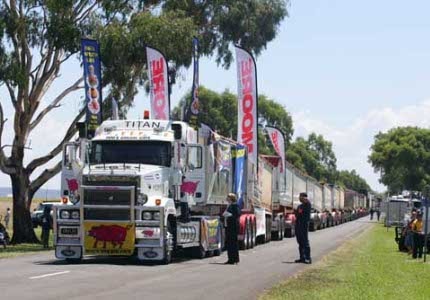If you ever thought that being overtaken on a highway by a speeding truck is a spooky experience, you haven't met these monsters. Whereas trucks are a common sight on European, American or Asian roads, in Australia the story goes a little different.
The sight of a smoky, dust disturbing creature in the distance in the Great Outback is enough of a sign to tell you you're about to see the mother of all trucks passing by.
The tractor head – simple, powerful, just as any other tractor head. What follows close behind however is from another league entirely. Two, three, even four trailers, attached to the aforementioned tractor head, swirl on the reddish, Australian dust, faithfully reacting to the driver's inputs...
They're called road trains and, even they are present in several parts of the world, the Australians invented them, gave them their own vehicle class, their own traffic rules and even their own traffic signs. And their all road-legal...
HISTORY
The Australian continent is, as you know, unlike any other. The vast distances that separate each city pose totally new challenges in terms of transport. Although moving people from place to place was done in the early 1900s in more ways than one, shipping materials, supplies and merchandise from one city to another needed to be done faster, and in bigger quantities. This meant that loading a single trailer was not enough.
The predecessors of the modern road trains took shape back in the 1930s, when the South Australian government began using military trucks to ship supplies to the North. Until then, the operation was being done by using the so called camel trains (several camels, trekking the desert between two points on a regular basis).
The trucks used in the early days to link the two sides of the continent, AEC 8x8s, were built by Hardy Motors on behalf of the Overseas Mechanical Transport Directing Committee. They consisted of an eight wheel tractor head and two eight wheeled trailers.
AECs were powered by an in-house built 8.85l 6 cylinder engine, developing at most 130 hp. The tractor head was as simple as it gets, lacking a closed cabin and with the engine radiator located behind the seats.
Even so, this crud means of transport quickly caught on and, despite its disadvantages (no driver protection, wide track, low speed and power) remained in service for some ten years. As they were operated by the government, private individuals still had to make ends meet the same old fashioned way.
The modern road train we see today was ushered by Kurt Johansson. The Australian from Alice Springs, a location which will later become synonymous with road trains, set out to create the first civilian operated road train by using a...1942 Diamond T80 tank retrieval tractor, left behind by the US Army.
Apparently, Johansson was dared into building a vehicle capable of carrying five times more cattle than it was possible at the time. With the help of the aforementioned truck, which he nicknamed Bertha, and his self-built tracking trailers, Johansson gave birth to the road train.
Today, Australia is the country with the biggest number of road trains. It is exactly this large number of trains in use today which lead to the implementation of a special set of rules and regulations to which they are subject to.
There are several types of road trains covering the Outback today, depending on their configuration and weight. The biggest of them can weigh up to 200 tons and be some 53.5 m (180 ft) long.
The smallest road train, if it can be called small, is called the B-double. It is made up of a prime mover (the tractor head) pulling two semi-trailers. The second largest, the B-triple, is the same as its smaller brother, but with an added semi-trailer.
The two main categories are completed by the C-train, a semi-trailer attached to either a B-double or B-triple train via a C-dolly.
So, making a truck capable of traveling that far, without breaking down and without having to refuel every 200 miles is a challenge in itself. Still, someone had to do it.
The most successful truck maker in the country is Kenworth. The company's Australian division was established in 1971 in Bayswater, Victoria and has since become an icon for Australian truckers. According to its own data, some 40,000 trucks have been delivered since.
Apart from the technical characteristics, a truck operating in the outback needs to comply with both customer requirements and driver's needs.
There are several thousand different configurations available for customizing each truck. Most of them are aimed at ensuring the driver's comfort and safety and they include sleeper boxes, lockers, oversized fuel tanks and, most importantly, 600+ hp engines.
Of course, there were several attempts made over the years to break the world's largest road train record, but nothing really compares to the one linked together for the February 2006 attempt.
Back then, Kenworth's competitor Mack and their new Titan tri-drive truck supported what would become the world's longest road train. So far.
When the assembly process was over, the road train measured - hold on - 1,474.3 meters (4,836 feet 11 inches). It was made up of a total of 112 trailers, each measuring a little over 10 meters. They were all driven for only 100 meters, but this was enough to set the new world record. Behind the wheel of the monster stood John Atkinson.
The predecessors of the modern road trains took shape back in the 1930s, when the South Australian government began using military trucks to ship supplies to the North. Until then, the operation was being done by using the so called camel trains (several camels, trekking the desert between two points on a regular basis).
The trucks used in the early days to link the two sides of the continent, AEC 8x8s, were built by Hardy Motors on behalf of the Overseas Mechanical Transport Directing Committee. They consisted of an eight wheel tractor head and two eight wheeled trailers.
AECs were powered by an in-house built 8.85l 6 cylinder engine, developing at most 130 hp. The tractor head was as simple as it gets, lacking a closed cabin and with the engine radiator located behind the seats.
Even so, this crud means of transport quickly caught on and, despite its disadvantages (no driver protection, wide track, low speed and power) remained in service for some ten years. As they were operated by the government, private individuals still had to make ends meet the same old fashioned way.
The modern road train we see today was ushered by Kurt Johansson. The Australian from Alice Springs, a location which will later become synonymous with road trains, set out to create the first civilian operated road train by using a...1942 Diamond T80 tank retrieval tractor, left behind by the US Army.
Apparently, Johansson was dared into building a vehicle capable of carrying five times more cattle than it was possible at the time. With the help of the aforementioned truck, which he nicknamed Bertha, and his self-built tracking trailers, Johansson gave birth to the road train.
MODERN ROAD TRAINS
After Bertha and the AECs, road trains really took off. They shortly became a must have in the country are were slowly adopted into every field of the industry, from live-stock shipping to transporting construction materials and mining operations.Today, Australia is the country with the biggest number of road trains. It is exactly this large number of trains in use today which lead to the implementation of a special set of rules and regulations to which they are subject to.
There are several types of road trains covering the Outback today, depending on their configuration and weight. The biggest of them can weigh up to 200 tons and be some 53.5 m (180 ft) long.
The smallest road train, if it can be called small, is called the B-double. It is made up of a prime mover (the tractor head) pulling two semi-trailers. The second largest, the B-triple, is the same as its smaller brother, but with an added semi-trailer.
The two main categories are completed by the C-train, a semi-trailer attached to either a B-double or B-triple train via a C-dolly.
CHALLENGES
As previously said, driving in Australia quite doesn't compare with driving anywhere else. When we said truckers have vast distances to cover, we really meant it. Say one needs to go from Darwin in the North to Adelaide, in the far South. That's about 3,020 km (1,880 miles)... A road with few gas stations, fewer settlements and, sometimes, no traffic for hundreds of miles.So, making a truck capable of traveling that far, without breaking down and without having to refuel every 200 miles is a challenge in itself. Still, someone had to do it.
The most successful truck maker in the country is Kenworth. The company's Australian division was established in 1971 in Bayswater, Victoria and has since become an icon for Australian truckers. According to its own data, some 40,000 trucks have been delivered since.
Apart from the technical characteristics, a truck operating in the outback needs to comply with both customer requirements and driver's needs.
There are several thousand different configurations available for customizing each truck. Most of them are aimed at ensuring the driver's comfort and safety and they include sleeper boxes, lockers, oversized fuel tanks and, most importantly, 600+ hp engines.
RECORD ROAD TRAIN
As is the case with every human made... something, the road train, being one of the largest types of trucks out there, needed to mark its territory. And what better way to do this than having its own Guinness Book of World Records entry?Of course, there were several attempts made over the years to break the world's largest road train record, but nothing really compares to the one linked together for the February 2006 attempt.
Back then, Kenworth's competitor Mack and their new Titan tri-drive truck supported what would become the world's longest road train. So far.
When the assembly process was over, the road train measured - hold on - 1,474.3 meters (4,836 feet 11 inches). It was made up of a total of 112 trailers, each measuring a little over 10 meters. They were all driven for only 100 meters, but this was enough to set the new world record. Behind the wheel of the monster stood John Atkinson.
